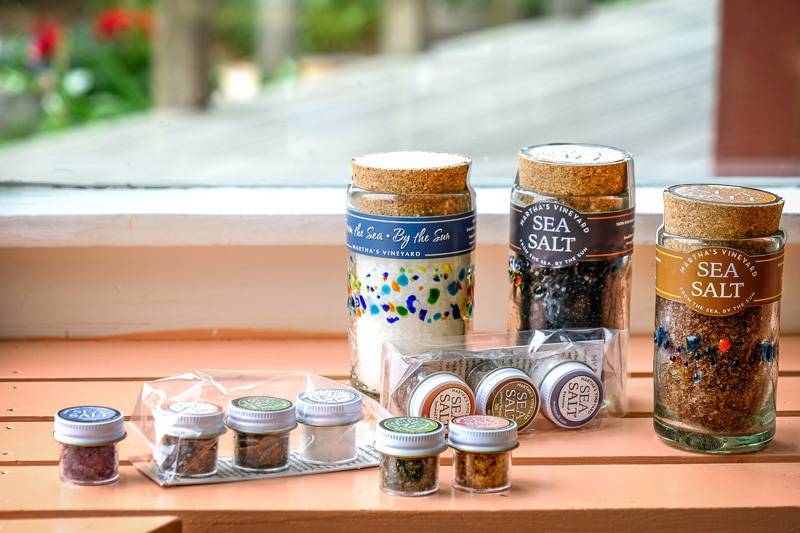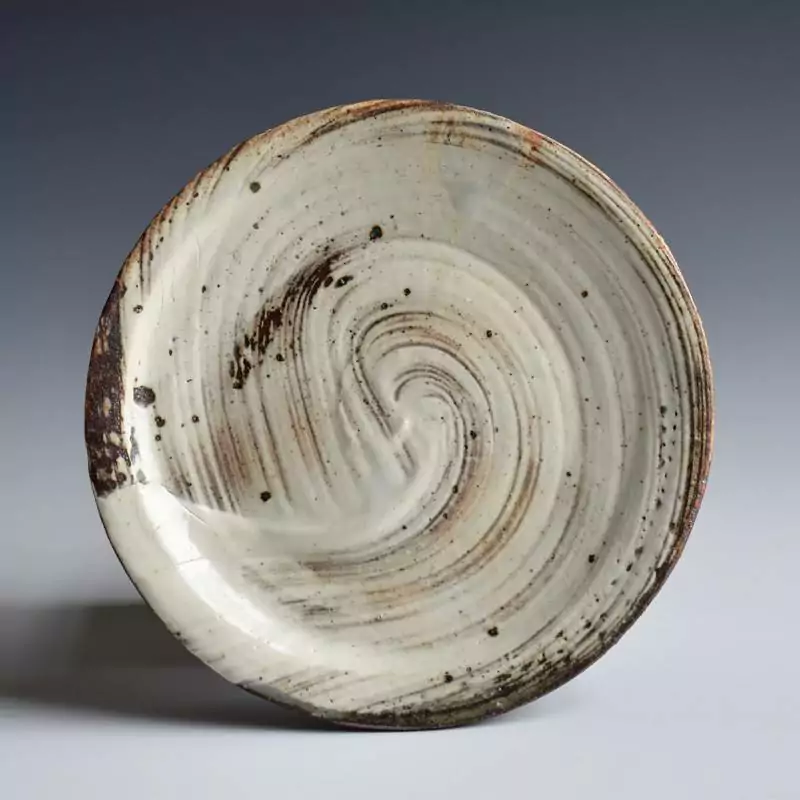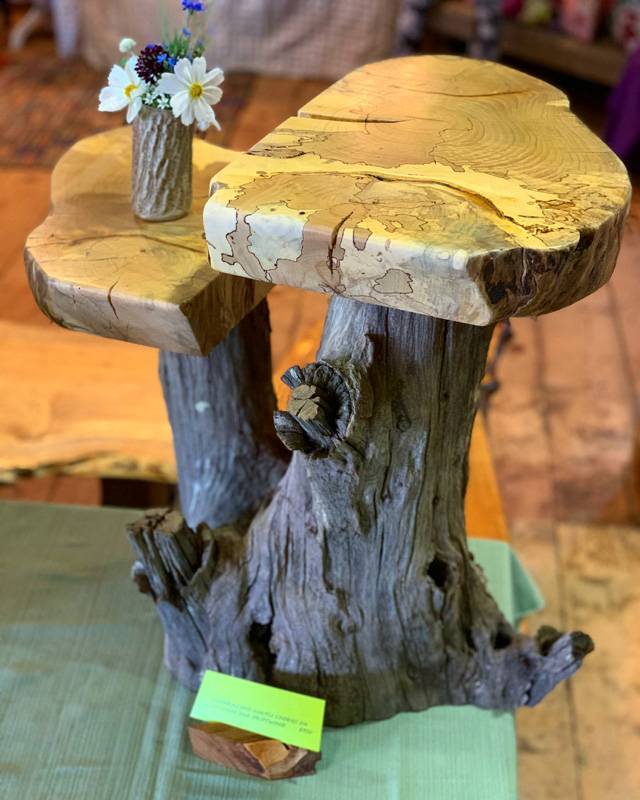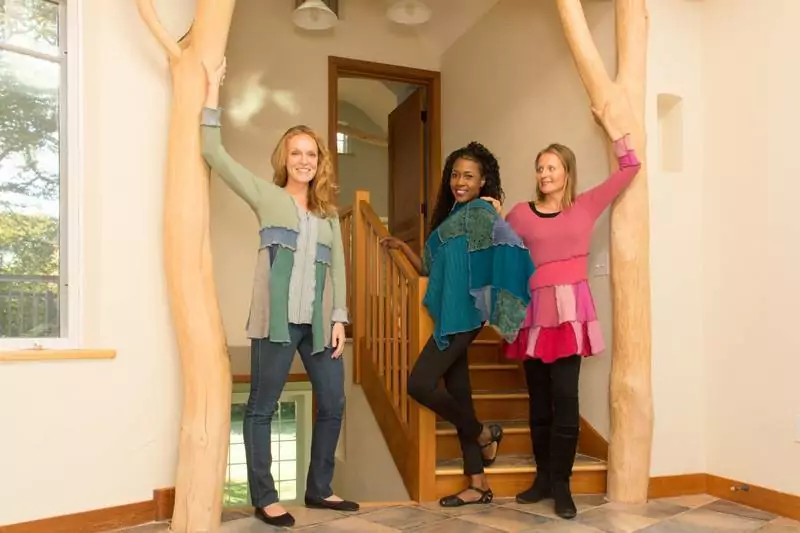Vineyarders! Looking for gifts? Keep it local.
SylvieBags
Sylvie Farrington is celebrating her 25th year of making all styles and sizes of bags from repurposed, vintage barkcloth. Barkcloth is a soft, thick, slightly textured fabric that was a popular choice in the 1940 to ’60s for drapery and upholstery projects. You’ve no doubt seen examples of the designs in old movies, or may even remember it from the curtains of your childhood. The heavy-duty fabrics come in fun, colorful patterns that truly exemplify the aesthetic of the midcentury modern home.
Farrington first fell in love with the look and feel of barkcloth when she found some of the fabric at an antique show in 1999. “The designs have such appeal,” she says. “They evoke a feeling of joy. They never really go out of style because they’re old to begin with. There’s a timelessness, and a sense of nostalgia.”

Each SylvieBag is handmade using authentic vintage barkcloth, sometimes pieced together with other heavy-duty cotton fabrics. Designs often incorporate hand-sewn Czech crystals for punctuation, and fun, rainbow-colored zippers sourced from a company in Switzerland.
Farrington comments on the durability of the fabric, saying, “It’s a sturdy cotton weave. They don’t make cloth like that anymore.” She adds that the colors don’t fade over time, or bleed when hand-washed. Her latest creation, a large, rugged tote, can even be thrown into the washer and dryer.
The designer sources her material from a variety of places, although she says that it’s getting harder and harder to find.
“People who sell me the fabric say they wouldn’t know what to do with it,” Farrington says. “It’s nice to know that I have an entire business based on something that was made a long time ago and that is getting revived into a brand-new item.”
The SylvieBag line includes pillows and potholders. Find all of the products at sylviebags.com. A selection of Farrington’s barkcloth pillows are also available at North Water Street Gallery in Edgartown.
Beldan Radcliffe — Upcycled Sweaters
Beldan Radcliffe loves textiles. A fiber artist, printmaker, and collage artist, Radcliffe began stretching her artistic boundaries just over a decade ago when she was inspired by the colors, textures, and patterns found in castoff clothing. Using thrift store finds, she started deconstructing secondhand sweaters and repurposing the knits to create colorful, collaged garments.
“It’s kind of like picking a palette,” says Radcliffe of her design process. “The same way that a painter would put together a palette, I look at the sweaters I have and pick the colors I think are going to work together.”
The resulting designs are unique and eye-catching, featuring wools and quality cottons and synthetics in coordinating colors with swaths of patterns here and there. You might see a bit of an argyle or Fair Isle knit blended into the design, or maybe even a fun stripe or floral weave. The garment’s structures themselves are always interesting. Edges are ruffled, cardigans often button up at the top, flaring out at the bottom for a skirt effect. Some pieces have roomy hoods made from layered colors. The upcycled sweater line also includes comfy collaged shawls, great for cooler weather. Each piece is one-of-a-kind, made from washed and preshrunk quality fabrics.
More recently, Radcliffe started making quilts and fun, bohemian skirts from repurposed T shirts and other all-cotton items. Her secondhand finds include patterns from butterflies and flowers to ethnic prints.
Radcliffe sees her efforts as a win-win. “I’ve always been interested in environmental issues and recycling, and not wasting anything,” she says. “I’m giving something another life — something that might have wound up in the landfill. And when I buy at the thrift store, the money goes back to charity. I’m supporting myself and helping others at the same time.”
Beldan Radcliffe designs can be found at the Night Heron Gallery in Vineyard Haven, and at the M.V. Artisans Festival. You can also purchase her upcycled sweaters and artworks through her website, beldankradcliffe.com.
Martha’s Vineyard Sea Salt
When life gives you unworkable soil, try farming salt. That’s exactly what Curtis and Heidi Feldman did when the small plot of land they purchased in 2001 with the thought of growing crops turned out to be useless clay atop limited soil. Undaunted, the two decided to stick with their dreams of leaving their mainland lives and establishing a farm on the Vineyard. Heidi realized that there was no local sea salt on the Island, so she and Curtis looked to the ocean for their “crop” source. In 2013, the Feldmans revived the centuries-old Vineyard tradition of farming salt when they launched their line, Martha’s Vineyard Sea Salt.
Harvesting and preparing sea salt for consumption isn’t easy. Curtis and Heidi must gather thousands of gallons of saltwater; filter out any sand, seaweed, and other organic matter, evaporate the water and leave the remaining sea salt to dry over time in a huge solar greenhouse-type structure; pile it into mounds for further evaporation; and then carefully gather the crystals for packaging. It’s a time-consuming, tedious process, but one that yields the purest product possible.

“We don’t add chlorine bleach, or drying or anti-caking agents,” Feldman says. “All of those things are considered quote, unquote, ‘safe,’ as per regulations. We want you to be able to taste the salt.”
Along with the natural flavor of salt, the Feldmans also create blends to combine the natural flavor of their salt with other complementary ingredients. Nine unique blends are available, including lemon verbena and dill; sumac, paprika, and garlic; local smoked oak; turmeric, cranberry, and white pepper; blueberry honey; herbes de Provence; porcini; and something they call “Naughty” — a blend of sea salt and activated charcoal.
M.V. Sea Salt offers its products in three- or five-pack assortments, salt spritzers, 3.5-ounce hostess jars, and pretty 5.5-oz jars decorated with a ribbon of sea glass.
Whichever you choose, M.V. Sea Salt products make the perfect gift from the Vineyard. “We want people to experience the taste and the joy of the Vineyard,” Heidi says. “They can put that salt on their tongue, and they’re right back there on the Island.”
M.V. Sea Salt is available from various purveyors around the Island, or buy directly from the website: mvseasalt.com.
Merry Farm Pottery
The famous Cliffs of Aquinnah (formerly Gay Head) are not the only place to find clay on the Vineyard. The Island is actually rich in clay, which is frequently dredged up during construction projects. Local artisan Micah Thanhauser has taken advantage of that abundance of waste material — often using clay unearthed during construction in the work he creates for his business, Merry Farm Pottery. He notes that the excess clay would otherwise have to be carted off-Island for disposal.
“Martha’s Vineyard happens to have very diverse and interesting clays,” says Thanhauser. “Nantucket doesn’t have any clay. Neither does most of the Cape.”

Thanhauser tries to keep the product as bare-bones as possible. He strains out pebbles and twigs, unless he is using the clay for a sculptural piece that might benefit from a rougher look: “My aim is to change it less and try to use more of a whole clay, without removing all of the impurities, and to find the beauty in that natural state.”
Thanhauser also sources some of his material from a North Carolina arts-centered community called STARworks, which describes itself as “the only ceramic supply company in the U.S. using local wild clays.”
The Island-born and -raised artist also mixes all of his own glazes, often using ash from his own wood stove.
This very organic approach to ceramics is reflected in Thanhauser’s simple designs, which are influenced by the time he spent studying in Japan. “The underlying philosophy in Japanese pottery is using materials that are unique to a region,” says Thanhauser. “Work is all designed around food and use. The main characteristic of Japanese ceramics is the emphasis on place and material.”
Merry Farm Pottery is located at 79 Merry Farm Road (off State Road) in West Tisbury. The studio and shop is open Thursdays, Fridays, and Saturdays from 11 to 5, or by appointment. You can also order online — shipping is available — at merryfarmpottery.com.
Stina Sayre
It was, of all things, a seat belt that inspired designer Stina Sayre to launch her line of women’s clothing and accessories. About 15 years ago, the Swedish-born former professional windsurfer had an idea for a bag design, but couldn’t find quite the right material for what she had in mind. The structure she was trying to create required a sturdy sort of flexible strip that could be wrapped into a spiral construction. Wide elastic proved to be too bouncy and stretchy. Not one to give up, Sayre noticed that the webbing used to make seatbelts possessed just the qualities she was seeking. She experimented to get the design just right, and the bag was a huge hit right away.
Flash-forward a couple of decades, and Sayre has now successfully established her brand of contemporary but timeless European-style clothing made from quality textiles, and incorporating unique design features. Her line, which she sells at her Main Street, Vineyard Haven, boutique, as well as online, has earned her a loyal following and a reputation as a visionary designer. All of her dresses, coats, pants, tops, bags, and swimwear pieces are sewn by small manufacturers in Massachusetts.

“When you have something made overseas by a big manufacturer, you have to order very large lots,” Sayre says. “That way a wholesaler or retailer can push the price down, but they have to overproduce, and a lot of clothing ends up in landfills.”
Although she adds new items to her clothing and accessories line every year, the seat belt–based bags — available in a satchel, travel bag, and crossbody diagonal style — continue to be bestsellers. The material does not come from used items, per se. Sayre purchases the heavy-duty webbing in rolls, but it is still a reclaimed product that would otherwise be wasted, since manufacturers always have excess.
“I chose it because I really enjoy repurposing,” says Sayre. “I like the fact that I’m taking a material that is intended for car safety and making it into a bag.”
Stina Sayre boutique is located at 43B Main Street, Vineyard Haven. You can also shop online at stinasayre.com.
Spirit of Tree MV
After years of working in custom cabinetry, Paul Farrington wanted to try something that involved working with wood in a more creative way. A few years back, Farrington, who runs the cabinetry shop for Holmes Hole Construction, started crafting one-of-a-kind pieces from wood reclaimed from felled trees or salvaged from construction projects around the Island. His coffee tables, end tables, chests, and mirrors all spotlight the various types of material he uses in its raw form, letting the beauty of the wood speak for itself.
Farrington creates his unique pieces using a variety of styles of woodworking. Tabletops are crafted using live-edge pieces — thick slices that are left uncut at the edges so that they show the natural shape of the tree. He often uses actual tree stumps as bases. More engineered parts of his creations are carefully sawn to coax out the individual beauty of the wood grain, creating a rustic appeal.

“Working as a cabinetmaker for a high-end contractor, the designs are not mine,” Farrington says. “They’re all squared off, and white or off-white — more conventional. That doesn’t express the beauty and the wonder in the wood that I see from day to day. To me, even though the wood is no longer alive, it still has so much vitality. I want it to shine for itself.”
When Farrington first started sourcing wood from trees that had either fallen down or were taken down for safety reasons, he was surprised at the interesting arboreal variety to be found on the Island. He uses wood from a number of different local species. “One of the things I really think is terrific is how some of these woods age. There are some really strong streaky colors and patterns from spalting [wood coloration caused by fungi]. I love the combination of colors and textures, and the way the wood grain presents flow.”
Farrington also sources antique wood from tear-down or renovation jobs, and even sometimes incorporates material that he salvaged from old ships during his days as a boatbuilder. “It’s all waste wood that would either go into a dump or a pit,” he says. “I love that I can give it a second life.” spiritoftreemv.com.

